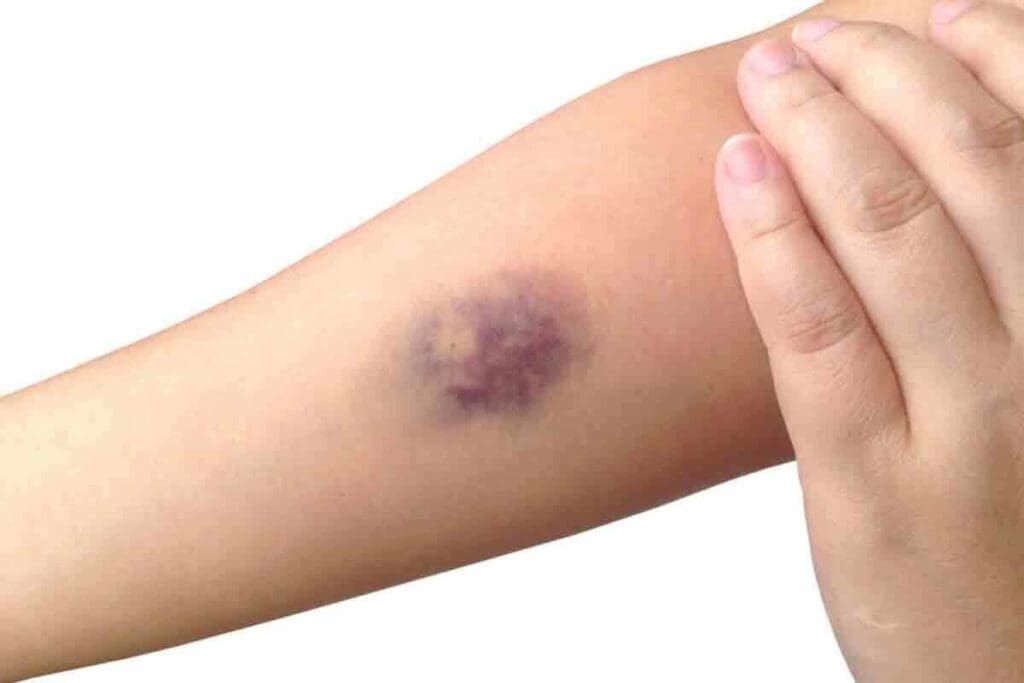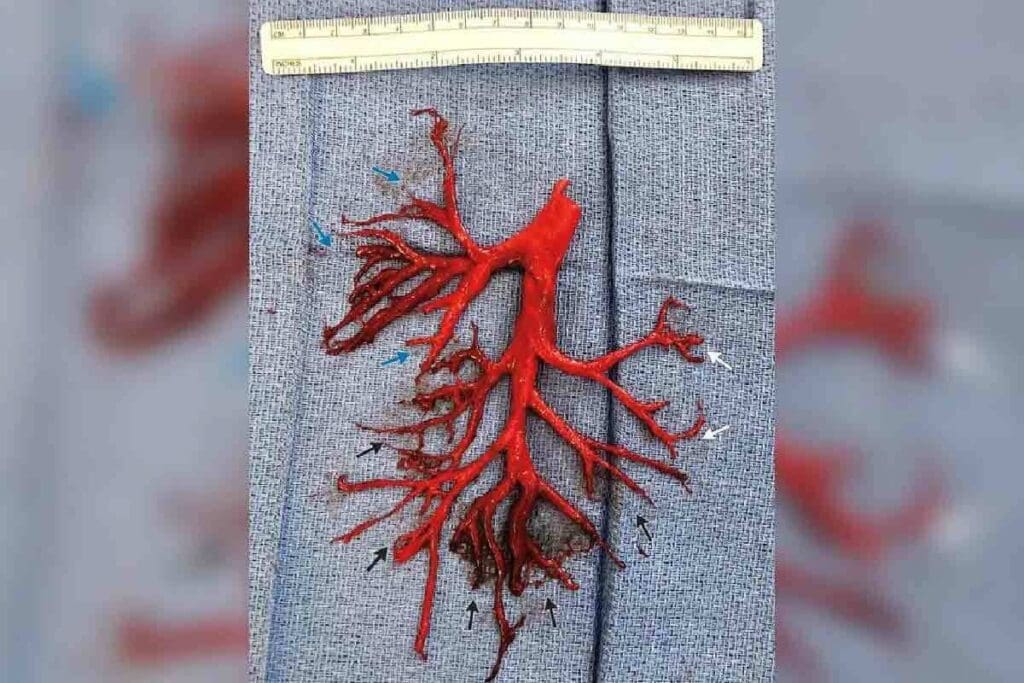Last Updated on November 17, 2025 by Ugurkan Demir

A blood clot in arm can sneak up on you without warning. While it’s less common than leg clots, it can be just as dangerous. Shockingly, up to 60% of people with arm clots don’t realize they have one until it causes serious issues.
At Liv Hospital, we stress how important it is to recognize the early signs and seek medical help quickly. Spotting symptoms early can greatly improve your chances of a full recovery.
Understanding the causes, symptoms, and risks of a blood clot in arm helps you act fast and stay safe. In this article, we’ll cover the 7 main signs and risk factors to watch out for—so you can protect your health before complications arise.

Deep vein thrombosis (DVT) is usually linked to the legs. But it can also happen in the arms, causing arm DVT. Knowing about arm DVT helps us spot its signs and understand its dangers.
Arm DVT is a type of DVT that happens in the arm veins. It’s when a blood clot forms in the deep veins of the upper arm. It can be caused by injury, staying in one place for too long, or genetics.
Arm DVT makes up about 4% to 10% of all DVT cases. It’s becoming more common, mainly in people in hospitals and those with central venous catheters. More people are getting diagnosed with arm DVT, which might make it seem more common.
Knowing how common arm DVT is helps doctors treat it better. It also shows why we need to spread the word about its risks and symptoms.

Knowing the signs of arm blood clots is key to better treatment. Spotting these symptoms early can stop serious problems and help patients more.
Swelling is a main sign of a blood clot in the arm. It happens because the clot blocks blood flow, causing fluid to build up in the limb.
Pain or cramping in the arm might mean a blood clot. This pain can feel like a dull ache or a sharp sting. It often gets worse when you move or touch the arm.
The area with the clot may feel tender to the touch. This is because the clot causes inflammation, making the area sensitive.
Skin discoloration is another sign, where the skin might look reddish or bluish. This happens because the clot blocks normal blood flow.
Some people might feel heaviness or warmth in the affected arm. Others might see visible veins or a cord-like structure. These signs can mean a thrombosis.
Understanding these 7 key symptoms—swelling, pain, tenderness, skin discoloration, heaviness, warmth, and visible veins—is vital. It helps in spotting and treating blood clots in the arm early.
It’s important to know the signs of a blood clot in the arm. This is because a blood clot can cause visible changes that need to be noticed.
A blood clot in the arm can make the area look different. You might see swelling, skin discoloration, and warmth or redness around it. The skin could look reddish or bluish because of inflammation and congestion.
The swelling can make the affected arm look bigger than the other. Sometimes, the skin might feel tight or stretched.
It’s key to tell a blood clot apart from other issues like muscle strain or cysts. A blood clot usually has swelling, pain, and skin discoloration together. These signs are more common in blood clots.
| Symptom | Blood Clot | Muscle Strain |
| Swelling | Common | Sometimes |
| Skin Discoloration | Common | Rare |
| Pain | Persistent | Variable |
Looking at pictures can help you understand better. Images of blood clots in the arm show typical symptoms like swelling and skin discoloration. But, always talk to a doctor for a real diagnosis.
Knowing what a blood clot in the arm looks like helps in early treatment. If you think you have a blood clot, get medical help right away.
Arm DVT can be dangerous even when you don’t feel any symptoms. This makes it hard to catch and treat early.
Research shows that 33% to 60% of arm DVT cases don’t show symptoms. This makes it tough to find and treat them quickly.
There are many reasons why some cases are asymptomatic:
Several things can make it hard to spot arm DVT:
Knowing about arm DVT is key to staying safe. Even without symptoms, you’re at risk for serious problems like pulmonary embolism.
“Early detection and treatment are key to preventing serious complications.” This is very important for people at high risk, like those with DVT history or recent surgery.
Here are some stats to show why awareness matters:
| Risk Factor | Increased Risk |
| Recent Surgery | Significantly higher |
| Family History of DVT | Moderately higher |
| Prolonged Immobility | Higher |
Knowing the risks and being aware of asymptomatic arm DVT can help catch it early. This can prevent serious problems.
Blood clots in the arm are called Deep Vein Thrombosis (DVT). They can happen for different reasons, mainly primary or secondary. Knowing why they happen helps in preventing and treating them.
Primary DVT happens without a clear medical reason. It often comes from hard work or intense activity. People who do a lot of exercise or move their arms a lot are at risk.
Examples of strenuous activities that may lead to primary DVT include:
Secondary DVT is caused by known factors or medical treatments. These can include:
| Cause | Description |
| Central Venous Catheters | Insertion of catheters into major veins for medical treatment can increase the risk of DVT. |
| Medical Conditions | Certain conditions like cancer, heart disease, or genetic clotting disorders can predispose individuals to DVT. |
| Surgery or Trauma | Surgical procedures or traumatic injuries to the arm can lead to DVT. |
It’s important to know these causes to take the right steps to prevent them. Also, seek medical help when needed.
Many things can make you more likely to get a blood clot in your arm. This includes how active you are and any health issues you might have. Knowing these risks is key to stopping them before they start.
People who play sports that use their arms a lot face a higher risk. This includes baseball, rowing, or weightlifting. These activities can put a lot of strain on the veins, which might cause clots to form.
Some health problems can make you more likely to get blood clots in your arms. These include:
How you live your life also affects your risk of getting arm blood clots. These include:
| Lifestyle Factor | Description |
| Smoking | Smoking harms the blood vessel lining, making clots more likely. |
| Obesity | Being overweight or obese can put more pressure on veins, mainly in arms and legs. |
| Prolonged Immobility | Staying inactive for a long time, like on a long flight or in bed, can cause clots. |
Where a blood clot forms in your arm matters. Clots in the upper arm might have different risks than those near the elbow. For example, thoracic outlet syndrome can raise the risk of upper arm clots because it compresses the subclavian vein.
It’s important to know the risks of blood clots in the arm. These clots are less common than in the legs but can be serious. They can even be life-threatening.
One big danger of arm DVT is the clot breaking loose and going to the lungs. This causes a pulmonary embolism. It happens when a clot blocks a lung artery, which can be deadly if not treated fast.
Pulmonary embolism symptoms include sudden breath trouble, chest pain, and coughing up blood. It’s key to get medical help right away if you see these signs.
While DVT is more common in the legs, arm DVT has its own risks. The chance of a pulmonary embolism is lower with arm DVT. But, it’s not zero, and it needs serious medical care.
| DVT Location | Pulmonary Embolism Risk | Common Symptoms |
| Leg | Higher | Swelling, pain, redness |
| Arm | Lower, but significant | Swelling, pain, discoloration |
Arm DVT can also cause long-term vascular damage. This includes chronic swelling, pain, and limited arm movement.
Post-thrombotic syndrome is another possible issue. It’s marked by chronic pain, swelling, and skin color changes. Knowing these risks shows why early diagnosis and treatment are so important.
Diagnosing blood clots in the upper body needs a mix of doctor checks and imaging. Doctors use different ways to find blood clots in the arm. The main goal is to stop serious problems like pulmonary embolism.
Ultrasound imaging is the top choice for finding blood clots in the upper body. It’s a safe method that uses sound waves to see inside the blood vessels. This lets doctors check if there’s a clot and how big it is. The Centers for Disease Control and say ultrasound is best for DVT.
Even though ultrasound is the main tool, other methods might be used too. These include:
These extra tests give doctors more info. They help plan the best treatment for patients with upper body DVT.
There are many ways to treat arm blood clots, from medicines to surgery. The right treatment depends on the clot’s size and where it is. It also depends on the patient’s health and any other health issues they might have.
Medicines that prevent clots from getting bigger are often the first choice. These include heparin and warfarin. Newer medicines like rivaroxaban and apixaban are also used. Anticoagulant therapy is usually needed for several months to make sure the clot goes away and doesn’t come back.
In serious cases, thrombolytic therapy might be used. This treatment breaks down the clot with special drugs. It’s used quickly for big clots or when there’s a high risk of serious problems.
For some, surgery might be needed if medicines don’t work. Surgery can remove the clot directly. Surgical removal can quickly help symptoms and is used for severe cases or when the clot is a big risk.
How long it takes to get better from an arm blood clot depends on the treatment and the person’s health. Most people start feeling better in a few days to a week. It can take weeks to months to fully recover, including getting rid of swelling and pain. It’s important to follow the doctor’s advice and go to all follow-up appointments.
Knowing about the treatment options for arm blood clots is key to managing the condition well. By working with healthcare providers, patients can get through the recovery and lower the chance of serious problems.
To prevent Deep Vein Thrombosis (DVT) in the arm, we need to make lifestyle changes and use medical treatments. Knowing the risks and using prevention methods can lower the chance of getting a blood clot in the arm.
Athletes, who often move their arms a lot, are more likely to get DVT. Proper exercise techniques can help lower this risk. It’s important to warm up before hard activities and not push too hard. Also, doing exercises that help blood flow, like arm circles and stretches, is good.
Drinking enough water and eating well are key to preventing DVT. Water keeps blood flowing and stops dehydration, which can cause clots. Eating lots of fruits, veggies, and whole grains also helps lower DVT risk.
Long periods without moving, like on flights or in bed, raise DVT risk. Moving and stretching can improve blood flow and lower this risk. It’s good to stand up and walk around every few hours, even for a short time.
People with a history of DVT or other risk factors might need medical prevention. This could include medicines or compression stockings. Talking to a doctor to find the best prevention plan is important.
By using these prevention strategies, we can greatly lower our risk of DVT in the arm. It’s important to be proactive and take a full approach to prevention.
If you notice swelling, pain, or tenderness in your arm, get help right away. Medical experts say quick action can lower the risk of serious problems.
It’s important to know the signs of a blood clot in your arm. This is because it can lead to serious issues like pulmonary embolism. Knowing the risks and taking steps to prevent them can save lives.
To live beyond arm DVT, you need to understand it well. By using safe exercise methods and drinking plenty of water, you can lower your risk of blood clots.
In short, knowing about arm DVT and when to get emergency care is key. Stay alert and seek medical help if you think something’s off.
A blood clot in the arm can cause swelling and redness. The skin may look discolored, with a reddish or bluish tint. Sometimes, you can’t see the clot on the outside.
Signs of a blood clot in the arm include swelling and pain. You might also notice tenderness and skin color changes. If you see these signs, get medical help right away.
Yes, blood clots can happen in the upper arm, though it’s less common than in the legs. They can be caused by health issues, repetitive arm use, and lifestyle choices.
Blood clots in the arms can stem from various causes. Primary DVT is linked to hard work, while secondary DVT is tied to medical procedures and health conditions.
Yes, arm blood clots are dangerous. They can break loose and travel to the lungs, causing a pulmonary embolism. They can also lead to long-term damage and complications.
Ultrasound imaging is usually used to diagnose arm blood clots. In some cases, venography or MRI might also be used.
Treatment for arm blood clots includes medicines and surgery. The choice depends on the clot’s size, location, and your overall health.
Yes, preventing arm blood clots is possible. Proper exercise, staying hydrated, and avoiding sitting for long periods help. Doctors might also recommend medicines for those at high risk.
Risk factors for arm blood clots include repetitive arm use and certain health conditions. Lifestyle choices like smoking or obesity also play a role.
Yes, athletes who do repetitive arm movements, like throwing or lifting, are at higher risk of arm blood clots.
Subscribe to our e-newsletter to stay informed about the latest innovations in the world of health and exclusive offers!